

The Science of “Intuition” The Art of Observation and How to Master the Crucial Difference Between Observation and Intuition. By Maria Popova Why genius lies in the selection of what is worth observing.
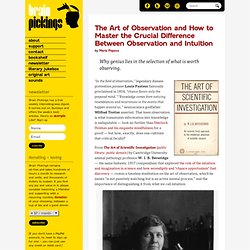
“In the field of observation,” legendary disease prevention pioneer Louis Pasteur famously proclaimed in 1854, “chance favors only the prepared mind.” “Knowledge comes from noticing resemblances and recurrences in the events that happen around us,” neuroscience godfather Wilfred Trotter asserted. That keen observation is what transmutes information into knowledge is indisputable — look no further than Sherlock Holmes and his exquisite mindfulness for a proof — but how, exactly, does one cultivate that critical faculty? From The Art of Scientific Investigation (public library; public domain) by Cambridge University animal pathology professor W. The Science of Inspiration (and How to Make It Work for You) Intuition Pumps: Daniel Dennett on the Dignity and Art-Science of Making Mistakes.
By Maria Popova “The chief trick to making good mistakes is not to hide them — especially not from yourself.”
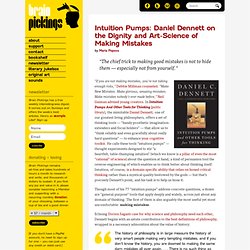
“If you are not making mistakes, you’re not taking enough risks,” Debbie Millman counseled. “Make New Mistakes. Make glorious, amazing mistakes. Make mistakes nobody’s ever made before,” Neil Gaiman advised young creators. Though most of his 77 “intuition pumps” address concrete questions, a dozen are “general-purpose” tools that apply deeply and widely, across just about any domain of thinking. Echoing Dorion Sagan’s case for why science and philosophy need each other, Dennett begins with an astute contribution to the best definitions of philosophy, wrapped in a necessary admonition about the value of history: He speaks for the generative potential of mistakes and their usefulness as an empirical tool: Sometimes you don’t just want to risk making mistakes; you actually want to make them — if only to give you something clear and detailed to fix.
Donating = Loving Share on Tumblr. Picasso on Intuition, How Creativity Works, and Where Ideas Come From. By Maria Popova “To know what you’re going to draw, you have to begin drawing.”
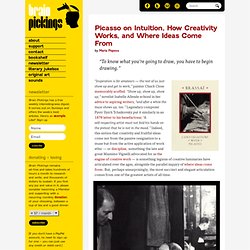
“Inspiration is for amateurs — the rest of us just show up and get to work,” painter Chuck Close memorably scoffed. “Show up, show up, show up,” novelist Isabelle Allende echoed in her advice to aspiring writers, “and after a while the muse shows up, too.” Legendary composer Pyotr Ilyich Tchaikovsky put it similarly in an 1878 letter to his benefactress: “A self-respecting artist must not fold his hands on the pretext that he is not in the mood.” Indeed, this notion that creativity and fruitful ideas come not from the passive resignation to a muse but from the active application of work ethic — or discipline, something the late and great Massimo Vignelli advocated for as the engine of creative work — is something legions of creative luminaries have articulated over the ages, alongside the parallel inquiry of where ideas come from. I don’t have a clue. Matisse does a drawing, then he recopies it.
Trying Not to Try: How to Cultivate the Paradoxical Art of Spontaneity Through the Chinese Concept of Wu-Wei. By Maria Popova “Our modern conception of human excellence is too often impoverished, cold, and bloodless.
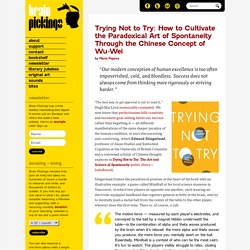
Success does not always come from thinking more rigorously or striving harder.” “The best way to get approval is not to need it,” Hugh MacLeod memorably counseled. We now know that perfectionism kills creativity and excessive goal-setting limits our success rather than begetting it — all different manifestations of the same deeper paradox of the human condition, at once disconcerting and comforting, which Edward Slingerland, professor of Asian Studies and Embodied Cognition at the University of British Columbia and a renowned scholar of Chinese thought, explores in Trying Not to Try: The Art and Science of Spontaneity (public library | IndieBound).
Our lives, Slingerland argues, are often like “a massive game of Mindball,” when we find ourselves continually caught in this loop of trying so hard that we stymie our own efforts. Art by Austin Kleon from 'Show Your Work.' Share on Tumblr. How Intuition and the Imagination Fuel “Rational” Scientific Discovery and Creativity: A 1957 Guide. By Maria Popova “Those who do not know the torment of the unknown cannot have the joy of discovery.”
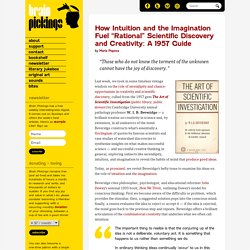
Last week, we took in some timeless vintage wisdom on the role of serendipity and chance-opportunism in creativity and scientific discovery, culled from the 1957 gem The Art of Scientific Investigation (public library; public domain) by Cambridge University animal pathology professor W. I. B. Beveridge — a brilliant treatise on creativity in science and, by extension, in all endeavors of the mind. Today, as promised, we revisit Beveridge’s hefty tome to examine his ideas on the role of intuition and the imagination. The important thing to realize is that the conjuring up of the idea is not a deliberate, voluntary act.
In allowing for these magic moments to occur, Beveridge stresses the importance of embracing uncertainty and doubt: He once again quotes Dewey, who advocated what he called “reflective thinking”: It is not possible deliberately to create ideas or to control their creation. Your Intuition Is Your Answer. “When you know, you know.”

I never understood this quote, until I understood it. Nine years ago, I stood in the doorway of the house in which I currently live, and declared, “I’m home,” without ever stepping foot inside. One month later, I moved in. Two and a half years ago, I visited my friend for a massage. Afterwards, she asked if I wanted to see the only available studio on the ranch (which had just been listed for rent).